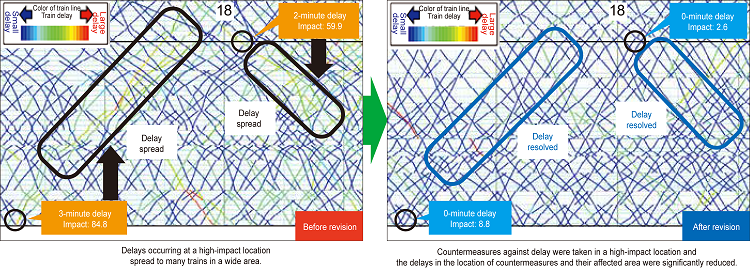21. Support system for countermeasures against delay based on the impact of delays
Chronic delay of trains is one of the major causes of reduction of passengers’ convenience. Aiming to improve the punctuality of train operations and to increase work efficiency for studying countermeasures to achieve this, we have developed a method to identify the sets of train and station where measures to prevent delays, such as the addition of running time or dwell time supplements, should be prioritized.
n terms of countermeasures against delay, it is empirically known that delays can be effectively reduced with fewer countermeasures if priority is given to locations where delays are likely to spread widely to other trains. Therefore, by newly defining the number of sets of train and station where delays tend to spread as an index of the impact of delay, and identifying the area to which the delay at each location spread based on the recorded data of daily delays, we have constructed a new method to quantitatively evaluate the impact of delays. Next, we have devised a method to extract the locations with a high degree of impact on average over a certain period of time (e.g., one month) as the priority locations for which countermeasures against delay should be considered, and developed a support system for countermeasures against delays implementing this method. This system makes it possible to study and develop effective countermeasures against delays in about one-fifth of the time required for a conventional method, leading to simultaneously improve punctuality and convenience and increase work efficiency.
As a result of applying this system to three actual rail lines, we confirmed that the locations of high impact calculated by the system were the same as the areas that the persons in charge of creating train timetables recognized the need for countermeasures. In addition, we added totally 90 seconds of running time or dwell time supplements to each intermediate station of the train with high impact, and changed the departure track of the train at the starting station as countermeasures at the timetable change, based on the locations extracted by the system. We found that the delays at and around the countermeasure points were reduced, confirming the validity and usefulness of this system (Fig. 1).

